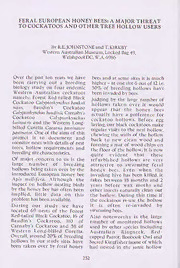
Feral European Honey Bees: a major threat to cockatoos and other tree hollow users PDF
Preview Feral European Honey Bees: a major threat to cockatoos and other tree hollow users
FERAL EUROPEAN HONEY BEES: A MAJOR THREAT TO COCKATOOS AND OTHER TREE HOLLOW USERS By R.E. JOHNSTONE and T. KIRKBY Western Australian Museum, Locked Bag 49, Welshpool DC, W.A. 6986 Over the past ten years we have bees and at some sites it is much been carrying out a breeding higher - at one site 6 out of 12 i.e. biology study on four endemic 50% of breeding hollows have Western Australian cockatoos been invaded by bees. namely: Forest Red-tailed Black Judging by the large number of Cockatoo Calyptorhynchus banksii hollows taken over it would naso, Baudin’s Cockatoo appear that the honey bees Calyptorhynchus baudinii, Carnaby's actually have a preference for Cockatoo Calyptorhynchus cockatoo hollows. Before egg latirostris and the Western Long¬ laying, our black cockatoos make billed Corella Cacatua pastinator regular visits to the nest hollow, pastinator. One of the aims of this chewing the walls of the hollow project is to document and back to new clean wood and monitor nests with details of nest forming a mat of wood chips on trees, hollow requirements and the floor of the hollow. It is now breeding site characteristics. quite evident that these Of major concern to us is the refurbished hollows are very large number of breeding attractive to swarming feral hollows being taken over by the honey bees. Even when the introduced European honey bee invading hive has been killed, it Apis mellifera. Although the takes between 18 months and 2 impact on hollow nesting birds years before wax moths and by the honey bee has often been other insects naturally clean out implied, little data on this the hollow. During this time if problem has been available. the cockatoos re-use the hollow During our study we have it is often re-invaded by located 69 nests of the Forest swarming bees. Red-tailed Black Cockatoo, 16 of Also noteworthy is the large Baudin's Cockatoo, 110 of number of monitored hollows Carnaby’s Cockatoo and 58 of used by other species including Western Long-billed Corella. Australian Ringneck, Red- Overall, around 20% of breeding capped Parrot, Boobook Owl and hollows in our study sites have Sacred Kingfisher (some of which been taken over by feral honey had nested in the same hollow 252 forests and woodlands including Jarrah-Marri, Karri, Wandoo and Salmon Gum (Figures 1 and 2). At one of our study sites near Dandaragan we have located over 200 feral beehives in a narrow 3km stretch of Wandoo woodland on a creek line. Many of these are in hollows that have been previously used by cockatoos and other birds. Other areas regularly visited over the past 10 years e.g. Christmas Tree Well, Bungendore Park, Wungong, Serpentine, Bannister, Kojonup and Lake Muir show a marked increase in feral bee numbers. Some of this possibly is due in the Wheatbelt to canola crops that apparently stimulate Figure 1. Stag Wandoo with 6 feral bee hives at Cataby 2004. every year over 20 years) that were invaded by feral honey bees during this period. In a number of cases birds were incubating eggs or brooding chicks when the hollow was invaded by the swarm. This clearly highlights the enormous problem of feral honey bees taking over hollows in southern forests and woodlands and we believe they pose a threat for the future conservation of many obligate hollow nesters. The strong tendency for honey bees to become feral, swarm and colonise new sites is now a major Figure 2. Swarming bees at Cataby in ecological problem in southern August 2006. 253 bees to swarm. This increase also introduce control measures applies to the Dongara-Jurien which could include: region where bees have colonised 1. Producing non-swarming holes in limestone cliffs, caves queen bees for the honey and and trees previously used by pollination industry. birds and in the Kununurra area 2. Eradication of feral hives in where they have been parks, gardens and reserves. introduced as crop pollinators. This can be done by using Of concern also is the fact that at trapping techniques such as one of our study sites “Swarm Catch” or with (Bungendore Park) we have chemical control. observed a number of small birds (Brown Honey eater, White¬ 3. Use of mobile water/feeding cheeked Honeyeater and stations with chemical or Western Little Wattlebird) killed fungal additive that would be by bee stings while feeding on taken back to hives. These flowering shrubs (in two of these could be small temporary the sting was still attached to the stations set up by land care orbital skin). groups, councils, government agencies etc. that could be set Action is now urgently required up in reserve areas to eradicate to both increase research on the feral hives. impact of feral honey bees and to 4. Use of queen bee excluders on commercial hives. 254
